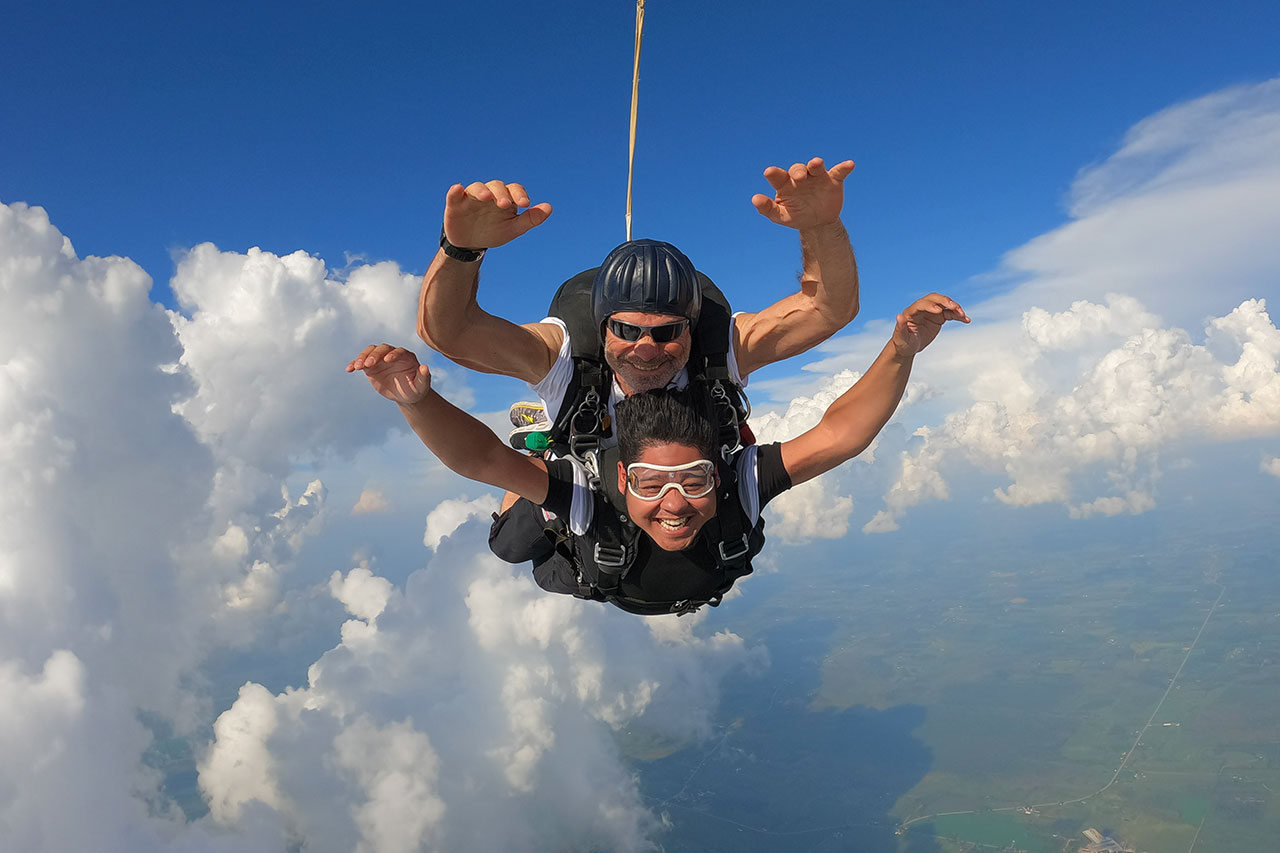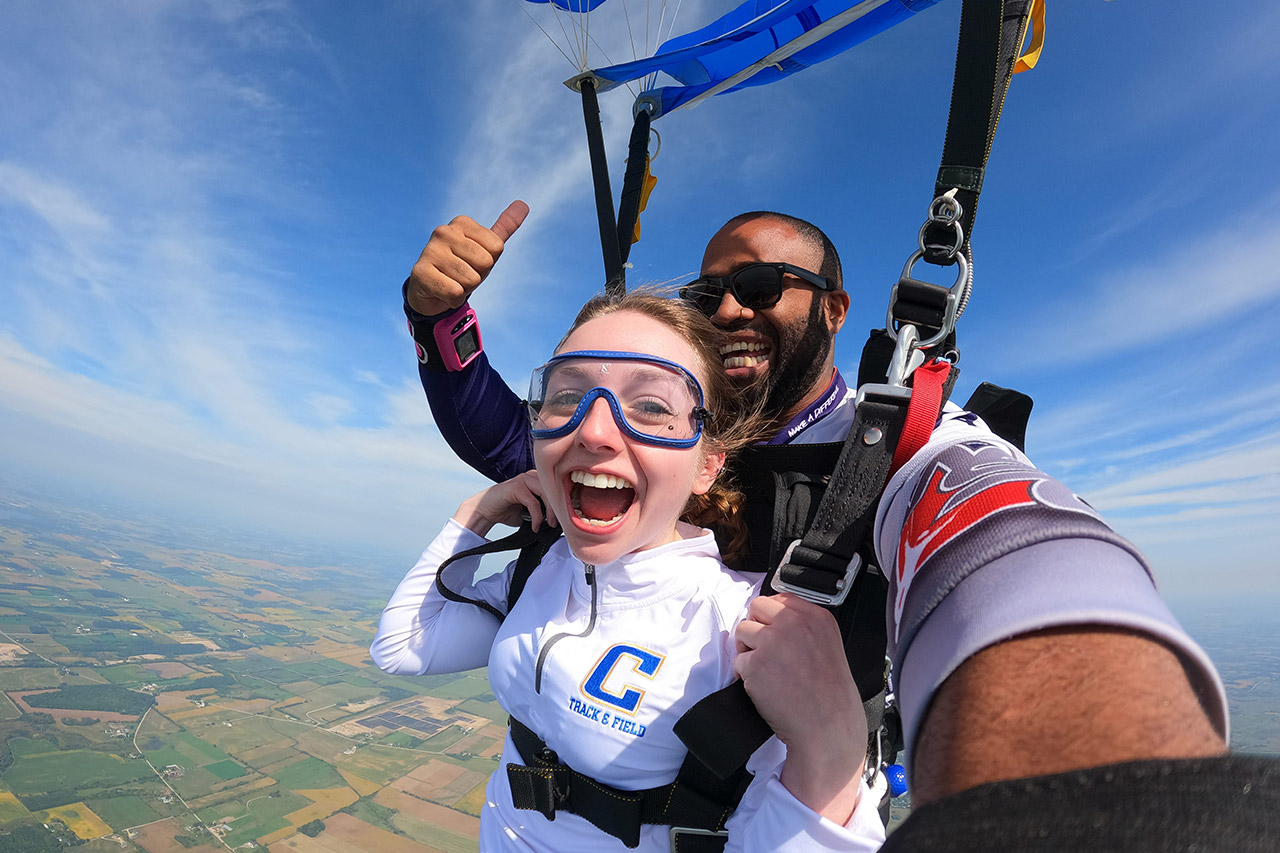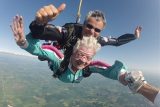How Fast Do You Fall When Skydiving?
General
Posted by: Wisconsin Skydiving Center 3 months ago
How fast do you fall when skydiving? Terminal velocity! When skydiving, you fall at a speed of about 120 mph (193 km/h) in a belly-to-earth position. But your speed can vary depending on weight, body position, air resistance or density, and clothing.
Let’s take a deeper dive and thoroughly answer the question, “How fast do skydivers fall?”
What Is Terminal Velocity?
Terminal velocity is the maximum speed an object reaches when the force of gravity pulling it downward is balanced by the air resistance pushing against it, causing it to stop accelerating. In skydiving, this air resistance stops us from speeding up to unsafe speeds. If air resistance wasn’t a thing there would be no way to stop our acceleration and safely deploy our parachutes!
To envision terminal velocity: imagine you drop a pancake off the kitchen counter – sigh, but no big deal. It won’t hurt your foot when it falls, because the height between the floor and the counter isn’t enough to allow for the pancake to reach terminal velocity.
If you threw the pancake off a skyscraper, however, it would have enough time to accelerate, and eventually, air resistance would balance out the force of gravity pulling it down, causing the pancake to stop accelerating and fall at a steady speed – its unique terminal velocity.
Terminal velocity takes a little bit of time to establish or build up, which is why skydivers aren’t falling at 120 mph the split second they leave the airplane! (And why, unlike its countertop cousin, this freaky-fast pancake might sting on impact.)

How Long Does It Take To Fall 1,000 Feet Skydiving?
For the sake of continuity, let’s think about our poor pancake that’s hurtling toward the earth. We’ll say the average flapjack has a terminal velocity of 30 mph. Does it reach 30 mph the very second it’s dropped from a building? Nope, and it’s the same with skydiving.
When we exit the aircraft, it takes us about 10 seconds to reach our max speed. This is because when we leave the aircraft, we are starting at zero downward velocity. We’re already moving forward in the plane, so there’s an aspect of speed there, but gravity isn’t pulling us down. In fact, we’re defying gravity in the plane. Due to the airplane’s forward speed, we don’t get that stomach drop feeling!
After that initial 10 seconds, things change and we’re falling at around 120 mph! After reaching terminal velocity, it only takes about five seconds to fall 1,000 feet, which means that a 15,000-foot skydive gives you around one minute of freefall time.
What Factors Affect Skydiving Speed?
The human max falling speed is a bit different for everyone, because of these different factors:
Weight.
As body weight increases, it takes a bit longer for air resistance to counteract the force of gravity. This is because the stronger initial pull of gravity on a heavier person is greater than that on someone who weighs less. Some people may have faster natural fall rates than others – which is why knowing how to orient our bodies is important!
Body position.
How can people of different sizes jump together? Body position! People can increase their surface area to fall slower, or decrease their surface area to fall faster. For example, someone falling on their belly will encounter more air resistance than someone who orients themselves in a head-down position.
Altitude.
Who holds the record for human max falling speed? That would be Felix Baumgartner – he fell at a speed of over 840 mph. How!? He jumped from a super high altitude of around 128,000 feet. At this height, the air is super thin, and the resistance is sparse. The average skydiving height is between 10,000 feet AGL (Above Ground Level) and 14,000 feet AGL, which both allow ample time for terminal velocity to be reached.
Clothing.
Drag, drag, drag. The clothes we wear skydiving matter! Baggier clothing creates more drag, and slows us down in freefall, because there is more surface area for the air to resist. Contrarily, when we wear tight-fitting clothing, our fall rate is easier to speed up. If people of different body sizes are jumping together, those who weigh more may opt for bulkier clothing and those who weigh less will wear something tighter. This is a change that is more easily controlled than adjusting body position, making it a ‘quick fix’ for students who haven’t mastered flying their bodies yet.

What Is A Drogue?
During freefall, tandem instructors deploy a small parachute-like piece of equipment called a drogue. The drogue helps slow the pair down and assists with the deployment of the main parachute (aka main canopy). Because the combined weight of the tandem jumpers is pretty high, drogues ensure they don’t fall too quickly! How fast do you fall when skydiving tandem? Still around 120 mph! BUT, this wouldn’t be the case without the drogue.
We Know Freefall Speed, But What About The Parachute?
How fast is freefall? Around 120 mph, but what about once we deploy the parachute? We must slow down pretty significantly, right? Precisely! How fast do you fall with a parachute? The parachute speed is about 15 mph forward on a normal sport canopy or a tandem canopy. The rate of descent can change based on the wing loading (how much the skydiver/s weigh compared to the size of their canopy) and on the design of the canopy. Some parachutes are designed for docile flight, while others are crafted for high-performance.
Despite the extreme speeds reaching while in freefall and even under the parachute, skydiving canopies are designed to slow skydivers to a comfortable speed that allows them to easily and comfortably stand up or slide in their landings. So, how hard do you hit the ground when skydiving? Hah! Generally, not hard at all – envision jumping off a chair or doing a baseball slide in!
Tempted to experience the speed for yourself? Book your jump with us today!



